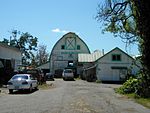John and Kate Dougherty Farmstead
1888 establishments in Washington TerritoryFarms on the National Register of Historic Places in Washington (state)Houses completed in 1888Houses in King County, WashingtonNational Register of Historic Places in King County, Washington ... and 2 more
Use mdy dates from August 2023Washington (state) Registered Historic Place stubs

The John and Kate Dougherty Farmstead is a farmstead located in Duvall, Washington, United States, listed on the National Register of Historic Places.
Excerpt from the Wikipedia article John and Kate Dougherty Farmstead (License: CC BY-SA 3.0, Authors, Images).John and Kate Dougherty Farmstead
Northeast Cherry Valley Road,
Geographical coordinates (GPS) Address Nearby Places Show on map
Geographical coordinates (GPS)
| Latitude | Longitude |
|---|---|
| N 47.74782 ° | E -121.98392 ° |
Address
Dougherty Farmstead
Northeast Cherry Valley Road
98019
Washington, United States
Open on Google Maps







